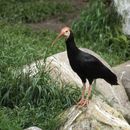Biology
(
Inglês
)
fornecido por Arkive
The southern bald ibis is a gregarious bird that feeds and roosts in large flocks (2). From the roost they fly with powerful wing beats interspersed with gliding and soaring, to suitable foraging areas. In groups of up to 100, this hunter and scavenger will walk along, pecking and probing at the soil, or turning over cattle dung and leaves, searching for prey such as caterpillars, grasshoppers, beetles, earthworms, snails, frogs, small dead mammals and birds (2) (5). The ibis will walk quickly over burnt grassland picking up dead and living insects (2) (5), and there have also been reports of the southern bald ibis collecting buttons, which is likely to be because they are mistaken for beetles (2), and not an unusual hobby! At dusk the southern bald ibis returns to its roost, which is situated on cliffs or in trees, in groups of up to 50, along with other ibises and herons.
The southern bald ibis nests on the ground, generally in colonies of 40 pairs or more. The male occupies the nest site first, which it will then defend with aggressive jabs with its bill (2). After attracting a mate, the male collects sticks and soft vegetation from which the female constructs a nest (2) (5). Clutches of one to three eggs are laid between August and October, and both parents regurgitate food to feed the young. The young fly after about 55 days, but depend on the parent's food for up to two months (2).
Conservation
(
Inglês
)
fornecido por Arkive
The southern bald ibis is listed on Appendix II of the Convention on International Trade in Endangered Species (CITES), which means that any trade in this species should be carefully regulated (3). It is also officially protected throughout its range (2), and occurs within a number of protected areas (4). The southern bald ibis is the focus of captive breeding programs underway in Pretoria Zoo and in Cape Town, which have the primary objective of reintroducing the species to Cape Province (5). The southern bald ibis is entirely dependent on the farming community for its survival, as the farmers own the land on which they feed and nest, and therefore the cooperation of land owners is vital in any conservation measures. In Transvaal, South Africa, cash incentives and warnings of prosecution played a part in the successful re-establishment of a colony of southern bald ibises (2). The protection and restoration of grassland habitat will also help ensure the continued existence of this weird and wonderful bird.
Description
(
Inglês
)
fornecido por Arkive
The scientific name of this strange looking bird means 'bald, old man', and refers to its bare head and wrinkled skin on the face and neck. The plumage is a very dark green, with highlights of iridescent green, bronze and violet, and shimmering copper patches on its shoulders. This contrasts sharply with the whitish bare skin on the head and neck, and the bright red crown, which is distinctly domed. The down-curved bill and legs are also red, and the eyes are an orangey-red. Long, fluffy feathers form a neck-ruff, which has a metallic blue-green hue (2). Juveniles lack the coppery patches on the wings, and have plumage that is more greyish in appearance (2). This is a relatively quiet bird that makes a weak gobbling sound, which led to their old Afrikaans name Wilde-Kalkoen, or wild turkey (2). However, they are noisy when they are at the nest, and when in flight give a high-pitched, turkey-like keeaaw-klaup-klaup (2).
Habitat
(
Inglês
)
fornecido por Arkive
The southern bald ibis inhabits short grasslands at high altitudes, generally between 1,200 and 1,850 meters. It avoids medium to long grass and other vegetated areas, and so prefers recently burnt, ploughed, mowed or heavily grazed fields and cultivated pastures (2) (5). The southern bald ibis generally nests on cliffs along deep river gorges, or by waterfalls (2).
Range
(
Inglês
)
fornecido por Arkive
Occurs in north-east South Africa, west Swaziland and Lesotho (4).
Status
(
Inglês
)
fornecido por Arkive
Classified as Vulnerable (VU) on the IUCN Red List 2006 (1), and listed on Appendix II of CITES (3).
Threats
(
Inglês
)
fornecido por Arkive
The southern bald ibis has always been hunted by humans; historically, young were taken by the Zulu to be used as medicine, Boer farmers shot this ibis during the South African wars to supplement their meat supplies, and settlers hunted it for both food and its feathers. Despite now being protected across its range, local hunting pressure remains a threat (2). However, the main reason for the species' decline in the early 20th century was the spread of karoo vegetation as a result of severe overgrazing of the grasslands. This, along with the planting of conifers in some areas, made large areas of grassland unsuitable for the ibis, and thus its range is now much smaller than it once was (2). Commercial afforestation and intensive farming continue to pose a threat to the southern bald ibis (4).

